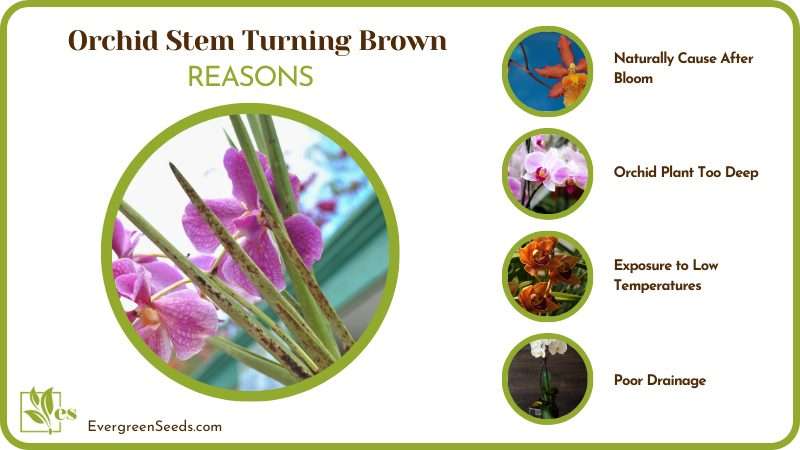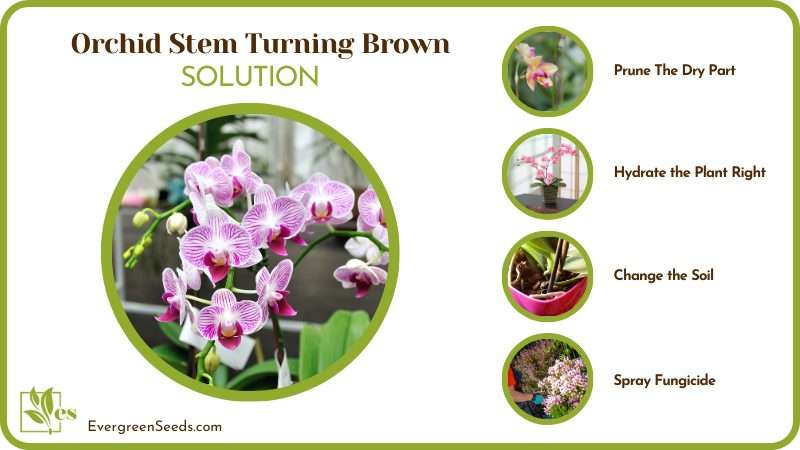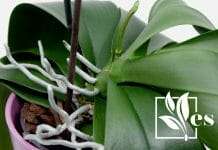Your orchid stem can be turning brown if it has completed a flowering cycle, is being grown in the wrong environment or if it has been affected by a fungal disease, popularly known as black rot or stem rot.

The reasons may be several but each of them can be easily tackled. If you are concerned about this condition on your orchid and want to find solutions to it, then this is the article you’ve got to read right now.
Our experts list out the reasons that can be causing this and also give you some easy and quick tips to tackle the condition, so wait no longer and read on.
Why Is Orchid Stem Turning Brown?
The orchid stem turns brown because after flowering it’s natural to do so, or it could be due to improper watering, stagnant water, root rot, sunburn, or it’s planted deep. Moreover, due to poor ventilation and drainage, high humidity, or even developing fungal spores.
– Naturally Cause After Bloom
After flowering, orchid flower spikes can naturally bring about the condition of stems turning yellow at first, followed by a brown shade. Hence the stems turning yellow and brown is a result of dieback, after the flowers have dropped off. It does not signify that the plant is dying, because you will also notice, in this case, only the orchid stem brown but leaves will be green.
– Improper Watering Schedule
Unlike several flowering houseplants, the orchids do not require frequent watering. Just enough water to keep the soil moist is required as too much water is going to lead to stem rot. The plant generally needs water once every week during winter and twice a week when it’s summer.
At the same time, the plant can not tolerate overly dry soil. So if you find your orchid stem dried out and brown be sure it is because of low hydration.
Thus be consistent in watering and keeping a watch on the moisture in the soil as orchids seldom tolerate both conditions over watering as well as drought. Both lead to a shock condition for the plant causing the stem to turn brown.
– Stagnant Water on the Stem
One of the prime causes for the orchid stem turning brown is the collection of stagnant water in the crevices of the stem and joints and gaps between orchid leaves.
This water easily breeds pathogens that love to thrive in damp spots leading to stem rot. This is probable even in the phalaenopsis orchid which is considered to be the easiest of orchids to grow.
– Root Rot
Much as root rot is a fungal disease that primarily occurs at the roots, the condition can aggravate leading to the spread of fungal pathogens up into the stems as well, which will cause them to turn brown and later into dead stems.
It is a classic outcome as the fungi spores spread to the different sections of the water channel. Root rot typically occurs if you have left the roots to sit in water for a long time. It can also occur if there is excess humidity around the plant or if you have overwatered your plant.
– Sun Burn
Sunburn causes the stems of the orchid to go brittle and brown. Orchid stems do not tolerate overexposure to sunlight. These are shade-loving plants and prefer indirect, diffused light. When they are under too much sun, the stems would start gradually losing their color before they are actually fully sun burnt, so turning brown is the first stage before they actually get damaged.
The orchids grow well in an environment closest to their topical notice, thus bright light tends to scorch their foliage. Hence, you must look out for sunburn, as this also results in the orchid stem turning pink.

– Orchid Plant Too Deep
Have you planted your orchid plant too deep into the soil? This could make the evaporation of water around the roots slower and increase moisture retention. Moreover, when the roots are too deep, it is difficult for oxygen to penetrate through the soil for the health of the roots. Which will cause the stems to weaken up and change their color.
Considering both these points, the stress borne by the plant is reflected on the stems as well. Moisture along with low levels of oxygen for the plant can be a hazardous condition for the plant.
– Poor Ventilation
A dingy and dark corner spot for your orchid? In such a case, the plant is surely going to struggle to cope. With poor ventilation and inadequate air circulation, you are putting it at risk of developing fungal disease and the stem turns black.
Moreover, overcrowding orchids too lead to poor ventilation around it and can suffocate the plant by increasing levels around it, thereby leading to discoloration of the stem to brown and becoming darker and even turning then to black.
– Exposure to Low Temperatures
Similar to the hydrangea stem turning brown, sunflower stem turning brown and rose stem turning brown, exposure to cold temperatures causes cold damage to orchids as well where the stems first turn white, then brown to black due to the death of the tissues.
Orchids thrive best in daytime temperatures between 80 and 90 degrees Fahrenheit. Note that the plant seldom tolerates chilly winds, frost and cold drafts and under this condition, the plant water will not evaporate and will be retained in the stems which eventually leads to black spots on the stem.
– Poor Drainage
If your orchid pot or container has poor drainage, such as the drain holes blocked by debris or stones, then it would end up retaining excess water. Moreover, heavy soil such as loamy or clayey soil for the orchids also leads to slow or poor flow out of water. Note that when it is in wet soil it also prevents the roots from taking in oxygen, so the stems receive less of it.
Both these conditions cause increased moisture, putting the plant at risk of stem rot due to the upward capillary action in the plant. Hence, you are sure to notice the Orchid stems turn brown followed by the Orchid stem turning black if ignored. The first hint might be white spots on the leaves, so pay attention.
– Excess Humidity
If you see that your orchids growing in a high humidity zone accompanied by still winds around, then you should note that the moisture in the air is coupled with the lack of air circulation reduces the evaporation of water from the foliage.
This tends to stagnate in the plant, causing pathogens to grow in joints and corners, leading to the development of stem rot, which could be somehow fatal to it in the long run.
– Fungal Spores
Fungal spores from other infected plants float around and can land on healthy orchids if the environment is suitable for them. They find breeding spots and spread across the plant foliage rapidly, affecting stem sections and leaf tips, by discoloring them. Overall, you will find the discoloration brown or the orchid stem turning yellow.
How To Fix Brown Orchid Stem?
To fix the brown orchid stem, prune the brown and dried part, hydrate it properly, maintain space between the orchid, cut the infected part, scale back on the watering, isolate it plant, change the soil, place it in the right container. Also, spray fungicidal solution, and adjust the ventilation.
– Prune The Dry Part
It is recommended to let the orchid spike on the stems turn yellow-brown and allow it to dry out completely as a natural process.
Once the flowers of the Orchid stem fall off, cut it back at a node at the base of the plant. You could alternatively also remove the brown stem completely. Clip it at the base where the stem has been turning yellow or brown and cutting back to the base of the plant gives a good boost to further growth.
It stimulates the production of blooms for a longer duration. If you have a double spike orchid, cut one spike that is at the base of the plant and another an inch above the node right under the flower bloom that is the lowest.

After this, you may wish to prune the stem to permit the plant to produce more blooms for a longer period. Remember to always prune your orchid plants with a sterile garden shear and tools, dipped in a diluted solution of isopropyl alcohol. This is an important step in preventing the spread of pathogens and thereby keeping the orchid plants healthy and thriving.
Don’t worry, the orchids will grow back after the stem has been cut. It may take around three months, but cutting back will direct the plant’s energy to grow better thus you will have a healthy orchid plant.
– Hydrate the Plant Right
Orchids do not need very frequent watering and the right amount is just to keep the soil moist. Never overwater the plant or allow the roots to sit in water for a long time.
As mentioned, overwatering increases the chance of fungal growth, thus staying away from adding in more until the soil has completely dried out. At the same time do not let the soil go completely bone dry.
The best way to know if your soil needs more water is to do a simple finger test. Dig your finger in by an inch and feel for moisture. If it comes out wet, abstain from adding in more.
– Maintain Some Space
Place your orchid plants in such a particular way that there will be enough space between the two plants, of course if it is two in one place. This will aid in air circulation and thereby prevent fungal pathogens from breeding on the foliage.
However, if you’re growing your plant in a still and dry zone, then you must set a fan at low to prevent any sort of rot and to facilitate the evaporation of water easily.
– Cut Infected Parts
The first thing that you must do as soon as you spot any discolored stem section is to snip away the portion, especially if it is stem rot so that it does spread across to other plant foliage.
Snip away the portion using a sterile garden tool and discard it far away from your garden so that the pathogens don’t enter the soil or onto other houseplants in your garden. Snipping away is the best way to localize the fungal disease and stem rot.
Even in the case of sunburned stems, cutting the damaged section aids the orchid to conserve its energy to grow a healthy stem to support a future bloom
– Scale Back on the Watering
Scale back on the watering as soon as you spot stem discoloration due to excess humidity. At first, don’t water much because water is a medium for the pathogens to spread further, if the root cause is an infestation, of course. Hence, you must wait for the soil to completely dry out and for the situation to improve before you add more water.
– Isolate the Plant
As soon as you spot the stem of your orchid turning black, isolate or quarantine the plant away from the rest of your garden or away from your indoor plants.
The key reason is that fungal spores traverse through the air and can easily infect nearby healthy plants. Overall, what you must do is isolate your plant Is necessary to prevent any other plant in the garden from being infected.
– Change the Soil
If your orchid is being grown in soil that’s heavy and not draining well, it is time to consider changing the soil. You may try and use potting soil mixed with perlite, peat, or wood shavings to increase aeration and better drainage around the roots of the plant.
In addition, you can even throw in some bark or worm castings along with organic compost to also increase the nutrient value in the soil.
– Shallow Plant in the Right Container
Orchid plants thrive best in shallow pots with at least six drainage holes. The roots don’t really need depth to take in the required oxygen. Ensure the holes in the pot or container freely permit flow out of water. This way, it will feel looser and not stuck in a compact place where the water would even accumulate and get stuck.
– Spray Fungicide
With fungal diseases in the aerial part of the plant, spray a fungicide containing copper to prevent its progression. Alternatively, you could use freshly ground cinnamon powder to tackle the progress of the fungal disease, if of course the main cause is fungus.
– Move the Plant to a Well-ventilated Spot
Keep your plant in a well-ventilated spot where there is ample indirect light that is reaching it. This is because orchids love bright yet diffused sunlight, and the best way that you can achieve this is to group them with larger plants which will form a natural canopy over them.

Another way is to create a greenhouse for the plants, which will protect them from the harsh rays of the sun. Ensure there is air circulation around the plant, which is essential for proper orchid care.
Final note:
Now that you know the reasons for your orchid stems turning brown, you can fix them easily. A little prevention goes a long way in keeping the plant healthy, so apart from tackling the problem, our experts also delve into means to ensure the condition does not occur.









